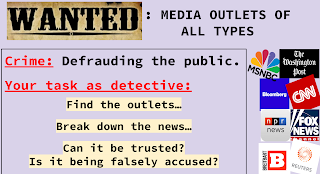How can we train students to better read and understand the news? How can they develop a “radar sense” of which news is trustworthy and which isn’t?
Technology is rapidly changing the “public marketplace of ideas”, so the 8th-grade Civics teachers Andrea Lacey, Stephanie Lukasiewicz, and MaryAnn Massumi have been developing innovative lessons and learning experiences that give students the tools by which they can verify what they read, see and hear.
 They start by showing students how the news media can serve as a gatekeeper, agenda-setter, and watchdog, but are essentially businesses focused on profit. Students become aware of the effect of this monetization and the various ways in which misinformation can make it into the media through catchy headlines, altered images, and the twisting of facts through hyperbole and oversimplification. Students also have to develop a sense of satire and bias and differentiate between facts and opinions of what they see and hear. By giving students a framework of lenses to consider what they see and hear about public affairs, they can then learn how to apply conceptual tools like verification, transparency, and corroboration to test for accuracy. Knowing these concepts is one thing - using them to vet the news while developing practices of civic literacy into a common habit is another.
They start by showing students how the news media can serve as a gatekeeper, agenda-setter, and watchdog, but are essentially businesses focused on profit. Students become aware of the effect of this monetization and the various ways in which misinformation can make it into the media through catchy headlines, altered images, and the twisting of facts through hyperbole and oversimplification. Students also have to develop a sense of satire and bias and differentiate between facts and opinions of what they see and hear. By giving students a framework of lenses to consider what they see and hear about public affairs, they can then learn how to apply conceptual tools like verification, transparency, and corroboration to test for accuracy. Knowing these concepts is one thing - using them to vet the news while developing practices of civic literacy into a common habit is another.
That's how we get to murder boards.
Bulletin boards of pictures, lines, quotes, facts, maps and diagrams that detectives use to solve crimes are an easily recognizable artifact of public culture, and perfectly suited to get 8th graders excited about getting to the bottom of a news story from the internet.
 Students working in groups go after news stories as if they were hunting a suspect in a crime using the tools of sourcing, verification, transparency, corroboration they just learned. This isn’t a quiet lesson. Students are telling each other about the publication or web site and how it has been placed on political spectrum diagrams, checking to see if other readers have tagged it on one end of the spectrum or the other. Some of the students are digging into the background of the author - Where did they go to college? Where else have they worked? What’s their reputation? What’s their resume look like?
Students working in groups go after news stories as if they were hunting a suspect in a crime using the tools of sourcing, verification, transparency, corroboration they just learned. This isn’t a quiet lesson. Students are telling each other about the publication or web site and how it has been placed on political spectrum diagrams, checking to see if other readers have tagged it on one end of the spectrum or the other. Some of the students are digging into the background of the author - Where did they go to college? Where else have they worked? What’s their reputation? What’s their resume look like?  That’s just the beginning. What about the facts in the news story - are they accurate? What are the words used to describe them? How do the words used in this news story compare to others describing the same event? Can any of the facts in the news story be corroborated? What other organizations are linking to this news story? Do they all come from just one side of the political spectrum?
That’s just the beginning. What about the facts in the news story - are they accurate? What are the words used to describe them? How do the words used in this news story compare to others describing the same event? Can any of the facts in the news story be corroborated? What other organizations are linking to this news story? Do they all come from just one side of the political spectrum? This lesson works because it gets students excited about a real-world development in real-time by setting the exercise in a competitive framework. Most importantly, it impresses students with the importance of reading news with suspicion.


